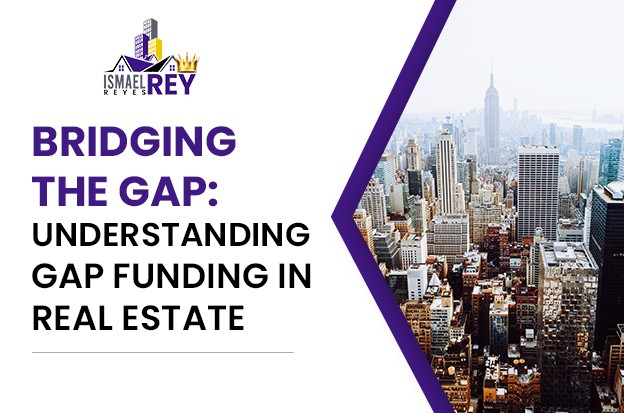Bridging the Gap: Understanding Gap Funding in Real Estate

What is Gap Funding?

1.What is Gap Funding?
Gap funding is a form of financing that provides short-term cash to cover the difference between what a borrower can afford to pay for a property and the full purchase price of the property. Typically, gap funding covers the down payment, closing costs, and first draw of repair costs. It is a form of leverage that can be used to get a deal done that would otherwise be unaffordable.
2.How Does Gap Funding Work?
Are you an aspiring multifamily real estate investor but struggling to secure funding for your next project? Do you find yourself stuck in the gap between your available capital and the required down payment? Gap funding might be the answer to your problem.
In this blog, we’ll take a deep dive into the world of gap funding, exploring the ins and outs of this unique real estate financing option. From the benefits and drawbacks to the lenders and borrowers involved, we’ll cover everything you need to know to make an informed decision about gap funding.
Whether you’re a seasoned real estate investor or a newbie in the industry, our Gap Funding 101 guide is designed to help you understand the essentials of multifamily investing and fill in the gaps – no pun intended – in your understanding of the process.
Gap funding is typically provided by a private investor or a lender, and it is secured by the property being purchased. The borrower may receive gap funding in the form of a loan or a joint venture partnership. In the case of a loan, the borrower will be required to pay back the gap funding with interest within a specified time frame, typically anywhere from six months to a year.
3.Advantages of Gap Funding
- Disadvantages of Gap Funding
How does Gap Funding work?

When a real estate investor does not have enough cash to cover the down payment or closing costs for a property, they can turn to gap funding. Essentially, gap funding is short-term financing that provides the necessary cash to close the deal. It covers the difference between what the investor has and what they need to seal a deal.
Here are some key aspects of gap funding explained:
Who provides gap funding?
Gap funding can come from a variety of sources, including private lenders, hard money lenders, and real estate crowdfunding platforms.
How is repayment structured?
Gap funding is typically structured as a short-term loan, with a term ranging from a few months to a year. Interest rates on gap funding are typically higher than traditional loans to compensate for the added risk that comes with short-term lending.
What are the benefits of gap funding?
Gap funding provides investors with the leverage they need to close real estate deals that they might have otherwise missed out on. By partnering with gap funders, investors are able to cover the gaps in their financing and move forward with more deals.
What are the risks of gap funding?
As with any form of leverage, gap funding comes with risks. If the real estate deal does not go as planned, the investor may find themselves in a situation where they cannot pay off their gap funding loan. This can result in foreclosure or even bankruptcy.
What are the risks of gap funding?
As with any form of leverage, gap funding comes with risks. If the real estate deal does not go as planned, the investor may find themselves in a situation where they cannot pay off their gap funding loan. This can result in foreclosure or even bankruptcy.
It is important to note that gap funding should not be used as the only means of financing for a real estate investment. Investors should always have a solid plan to pay off the loan, whether it be through selling the property or refinancing.
💡 key Takeaway: Gap funding is a tool that real estate investors can use to cover the gaps in their financing. While it provides leverage, investors should be mindful of the risks that come with using it and have a solid plan in place for repayment.
Understanding the Risks with Gap Funding

Gap funding is an innovative way to finance real estate deals when traditional financing options fall short. However, using gap funding comes with its own risks that borrowers should assess before jumping at the opportunity.
Here are some potential risks involved with gap funding:
- High-Interest Rates: Gap funding is usually considered a higher-risk financing option compared to traditional loans. As such, interest rates for gap funding can be significantly higher than other forms of financing. According to some sources, gap funding interest rates in real estate can range from 8% 15%. Borrowers should analyze the financing costs and compare them across several options before committing to any one lender.
- Short Repayment Terms: Gap funding typically has a shorter repayment term than traditional financing options. This is because gap funding is usually provided as a short-term loan to cover the immediate costs of the deal. As such, borrowers may need to repay the loan quickly, placing additional burden on their finances.
- Collateral: Gap funding lenders often require a higher level of collateral than traditional lenders. This means borrowers may be required to put up more assets (such as equity in other real estate) to secure the loan.
- Dealing with Multiple Lenders: In many cases, borrowers need to use multiple sources to finance a deal with gap funding. This translates into coordinating with different lenders and dealing with multiple interest rates, fees, and repayment schedules.
- High Risk: Using gap funding in a real estate deal increases the investor’s level of risk. This is because the debt obligation associated with the loan becomes an added expense on the overall deal, one that needs to be paid off before the investor can earn a profit.

Benefits of Gap Funding for Real Estate Investors

Benefits of gap funding for real estate investors
Gap funding, also known as bridge financing, can be an attractive option for real estate investors who need additional funds to top up the existing capital for a real estate project. Here are some benefits of gap funding for real estate investors:
- Helps Secure Deals: Gap funding can allow investors to secure deals that may have been out of reach without the extra funds. For instance, a rehabber who falls short on the down payment, closing costs, or rehabilitation budget can use gap funding to cover the shortfall and secure the deal.
- Reduces Risk: Gap funding can reduce risk for investors in real estate projects. Using gap funding allows investors to leverage other people’s money to complete a project and reduces the investor’s risk of losing their initial capital. Instead of taking on the entire financial burden of the project, the investor can share the risk with the gap lender.
- Offers Flexibility: Gap funding can offer flexibility in real estate deals. Investors can use gap funding to cover a wide range of expenses, including property acquisition, rehab costs, and even marketing. This flexibility allows investors to tailor their financing structure to fit their specific needs.
- Profitability: Lastly, gap funding can be profitable for investors. By using other people’s money, investors can leverage their capital and increase the return. A successful return on investment (ROI) will not only allow investors to complete the project, but also to make a profit.

Types of Gap Funding

types of gap funding
Gap funding is a form of financing used by real estate investors to cover the gap between the acquisition cost and the amount of money they have available. It is a short-term loan that helps investors get the funding they need to close a deal.
There are several types of gap funding options available, including:
1) Hard Money Loans – This type of gap financing is based on the value of the property. Hard money lenders typically lend up to 70% of the property’s value and require a higher interest rate to offset the risk. These loans are short-term, usually ranging from 6 to 12 months.
2) Private Money Loans – Private money loans are similar to hard money loans but come from private individuals rather than institutional lenders. These loans are often more flexible than hard money loans as the terms can be negotiated between the borrower and the lender.
3) Bridge Financing – Bridge financing is a short-term loan used to bridge the gap between the acquisition of a new property and the sale of an existing property. This type of gap funding is usually used by investors who need to move quickly on a new deal but have not yet sold their current property.
4) Seller Financing – Seller financing is when the seller of a property finances the purchase for the buyer. This type of gap funding can be advantageous for both parties as it allows the seller to receive a steady income from the buyer while the buyer obtains financing they may not have been able to get through traditional means.
5) Joint Venture (JV) Financing – A JV financing arrangement entails two or more parties pooling their resources to acquire a property. This can be a great option for investors who want to take on larger deals but do not have the resources to do so on their own.
In conclusion, gap funding is a valuable tool for real estate investors, but it is important to understand the risks associated with leveraging debt. Investors should select the type of gap funding that best fits their needs and their investment strategy.

Qualifying for Gap Funding

qualifying for gap funding
Gap funding can be an excellent resource for real estate investors who find themselves short on the funds they need to complete a deal. However, not everyone will qualify for this type of financing. Here are some of the factors that lenders will consider when deciding whether or not to extend gap funding to a borrower:
- Credit Score
Just like with traditional lending, lenders will consider a borrower’s credit score when determining if they qualify for gap funding. A good credit score will increase the likelihood of approval, while a subpar score may disqualify a borrower altogether.
- Experience Level
Lenders will also consider an investor’s experience level when deciding whether or not to extend gap funding. Borrowers with a proven track record of successful deals are more likely to be approved for this type of financing.
- Collateral
Gap funding is typically secured by the property being purchased, so lenders will want to ensure that the collateral is sufficient to cover the loan amount in the event of default.
- Exit Strategy
Lenders want to see that the borrower has a solid exit strategy in place to pay off the gap funding loan. This could include refinancing, selling the property, or using other sources of financing to pay off the debt.
- Property Analysis
Lenders will also analyze the property itself in terms of its value, condition, and potential for future profits. This analysis will help them determine whether the property is a good investment and whether the borrower is a good risk.
- Cash Reserves
Lenders want to see that the borrower has some cash reserves in case of unexpected expenses or setbacks. This shows that the borrower is financially stable and able to weather any storms that may arise during the course of the deal.

Finding the Right Gap Funding Lender

finding the right gap funding lender
Gap funding can be a useful tool for real estate investors to bring their deals to fruition. Whether you are looking for gap funding to cover the down payment, closing costs, or repair costs, finding the right lender can be the key to success. Here are some important factors to consider when looking for the right gap funding lender:
- Reputation: Choose a lender with a solid reputation in the real estate market. Check for reviews and testimonials from other borrowers who have used their services before.
- Experience: Make sure the lender you select has experience in providing gap funding for real estate transactions. Ask for their track record and ask for case studies.
- Loan terms: Be sure to carefully review the loan terms to ensure they align with your goals. Are the interest rates competitive? What are the origination fees? What is the repayment period?
- Flexibility: Look for a lender who is flexible and willing to work with you. Do they offer custom loan structures that are tailored to your unique needs? Are they willing to negotiate terms if necessary?
- Speed: Time is often of the essence in real estate deals, so make sure the lender can move quickly. How fast can they provide the funding you need?
- Transparency: Finally, always look for a lender who is transparent about their fees, interest rates, and other loan terms. Make sure you understand exactly what you are getting into before you sign any agreements.
By considering these factors, you can find a gap funding lender who can provide the financing you need to complete your real estate transactions. Just remember to use leverage carefully and responsibly, and always weigh the risks against the potential rewards.

Conclusion and Final Thoughts on Gap Funding

In conclusion, gap financing can be a powerful tool in the real estate investor’s toolkit. When used strategically, it can help investors close more deals and earn higher profits. However, it is important to remember that gap funding is a form of leverage and must be used carefully. The higher the leverage, the higher the risk. The key is to find the right balance between risk and reward.
Here are some final thoughts and tips to keep in mind when using gap funding:
- Always do your due diligence before investing in any deal. Make sure the numbers work and the deal is solid before seeking gap financing.
- Be sure to understand and negotiate the terms of the gap funding. Read the fine print, understand the interest rates and fees, and be aware of any potential risks or downsides.
- Use gap funding selectively and strategically. Don’t use it as a crutch for unprofitable deals or as a shortcut to avoid doing the necessary legwork.
- Have a solid backup plan in case the deal falls through or the gap funding falls through. Never rely solely on gap funding to close a deal.
- Finally, always remember that real estate investing is a business. Treat it as such and make rational, informed decisions based on the numbers and the potential return on investment.


Conclusion
The best way to use gap funding in real estate is to be very selective. Only invest in deals that you are confident you can afford to lose. And always use as much leverage as necessary to get the best possible return on your investment.
FAQ

If an investor does not meet the requirements for gap funding, they may have to miss out on a potential deal.
There are a variety of sources of gap funding, including family and friends, banks, and angel investors. You may also want to look into online funding platforms like Fundable and Lending Club.
Gap funding is a type of financing where a lender provides a short-term infusion of cash to help a borrower cover the down payment, closing costs, and first draw of repair costs for a real estate deal.
After getting gap funding, the next steps are to submit the loan request to the lender, work on the terms of the loan, and finally, get the loan approved.
The gap funding process is a way to provide money to a borrower who may not have enough available cash to cover the down payment, closing costs, and first draw of repair costs for a real estate deal. Borrowers use gap funding to bridge the gap between what they can afford and the amount they need to borrow.
To apply for gap funding, you’ll need to submit an application and a proposal to the lender. You’ll need to provide information about the property, the terms of the loan, and your financial status. You’ll also need to provide documentation of any liens or other legal proceedings that may affect the property.
There are a few requirements that must be met in order to qualify for gap funding in real estate. The most important requirement is that the property must be worth the investment. The property must also have all the necessary permits and licenses in place. There must also be a willing lender who is willing to provide a loan without any additional strings attached.
There are a few risks associated with gap funding. The biggest risk is that the deal won’t close. If the deal falls through, the investor may have to return all or part of the money they invested. Another risk is that the borrower won’t be able to make the payments. If the borrower can’t make the payments, the lender may have to take the property back.
Some things to consider when faced with a cash crunch are to review the deal, assess the viability of the property, and look for other ways to raise the money needed. Some possible ways to raise money include: finding a partner, asking family and friends for loans, selling assets, and taking out a loan in a related asset.
Some of the benefits of gap funding include: – Increased chances of a successful deal: When financing a deal with gap funding, the investor has more of an opportunity to make a successful purchase. – Increased chances of a successful purchase: Gap funding allows the investor to put more money down and increase the chances of a successful purchase. – Increased chances of a successful sale: Gap funding allows the investor to put more money down and increase the chances of a successful sale.
The first step in the gap funding process is to identify the properties that would be a good fit for gap funding. Once you have a list of properties, it is important to do your due diligence to make sure that each one is a good investment. Next, you will need to identify the sources of financing that would be a good fit for each property. Once you have identified the sources of financing, you will need to put together a financing proposal for each property. Finally, you will need to meet with the borrowers and get them on board with the deal.
Are you a multifamily investor struggling to fund your deals? Do you have a property you want to invest in, but don’t have enough money to close the gap? If so, you are not alone! Gap funding has emerged as a popular solution for multifamily investors who need to bridge the financial gap to close the deal.
In this blog, we’ll discuss Gap Funding 101, the ultimate guide to multifamily investing prologue that will help you understand the basics of gap funding. We understand the pain points of multifamily investors looking for funding, and that’s why we’ve curated this informative blog to help you make an informed decision about gap funding.
We’ll share the nitty-gritty details of gap funding, including what it is, how it works, its benefits and drawbacks, and much more. You’ll gain insights into why Gap funding has become increasingly popular among multifamily investors who need to make quick deals in a competitive market.
So, sit tight, grab a cup of coffee, and read on to learn everything you need to know about gap funding for multifamily investing prologue. With this information, you’ll be better equipped to make a profitable decision for your next multifamily investment.To put it simply, gap funding is like a bridge that connects you from where you are to where you want to be. Just as a bridge fills the gap between two points, gap funding fills the financial gap between what you have and what you need to close a deal.
About Ismael Reyes :-
Ismael Rey Reyes, is passionate about helping you achieve financial freedom through the power of passive income from multifamily real estate investments. With experience in multifamily acquisitions and capital raising, Rey has dedicated himself to multifamily investing full-time since 2016. Under his leadership, MI Real Estate has successfully invested in more than 15 multifamily properties in Alabama, Florida, Georgia, Texas, and Tennessee, with a combined portfolio of over 1200+ units valued at over $150 million. Join Rey to forge your path to financial prosperity.
Schedule A One Time Free 20 Mins Strategy Call with Ismael “Rey” Reyes.
Private consultation times available at: https://ismaelreyreyes.com/one-on-one-strategy-call/

